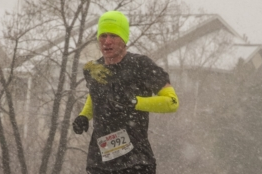
For 2022, I ‘m on the Dry Creek Striders racing team. It was started a couple of years ago by a friend of mine with two people and it’s now four. While most of us have run longer races including marathons, we primarily enter 5Ks and 10Ks and our individual training plans revolve around those distances. (We also do light training runs together, followed by heavy burritos.) We’ve not done any official races yet this year, but we did a 5K time trial this weekend on the Dry Creek Trail. This is an east-west suburban trail system that runs from Standley Lake in Westminster to I-25. And, it’s obviously the source of our team name.
Our 5K course was out-and-back on the central portion of the trail and its advantage is that it’s very flat. We did it last year and a ridiculous headwind on the out portion ruined the trial, though it did nearly guarantee a negative split on the return portion.
It’s important to clarify these as time trials. Not only are they not official races but the only variable is our individual times. To mix things up, we’ll sometimes do waterfall starts, where we start in reverse order of how we usually finish. We depart the line one at a time, separated by the amount of time we think we’ll be behind the next person. If we’re all accurate on our predictions, we should have everyone finishing at the same time and pushing each other as we sprint towards the line.
This weekend, with no wind in the forecast, a good, flat run was in the works. As it was the first time we’d all run at race pace in some months, no one figured to have a personal best. In a dramatic and unwelcome twist, the wind showed up right before we started, pretty much guaranteeing a slower day. We’d considered a waterfall start but bagged that at the last minute for a traditional one.
At first, the wind didn’t seem too bad. As we ran further along the course, the wind intensified, leading us to wonder if this course is cursed. By the turnaround, our paces all dropped to levels we barely felt comfortable acknowledging. We did still enjoy the benefits of a tailwind on the way back, but it never seems like that perfectly balances out the headwind going out.
The times at the end? Suffice to say it’s probably a good thing we did a trial instead of a formal race. It can teach you quite a bit about where you are speed-wise, and what needs to happen so that the next race is better. Generally it’s not rocket science (one needs more miles and/or more speed) but the stark reminder is useful.
Next up for the team? Most likely an official race in mid-March that’s 7.77K in celebration of St. Patrick’s day. Possibly heavy burritos afterwards.


